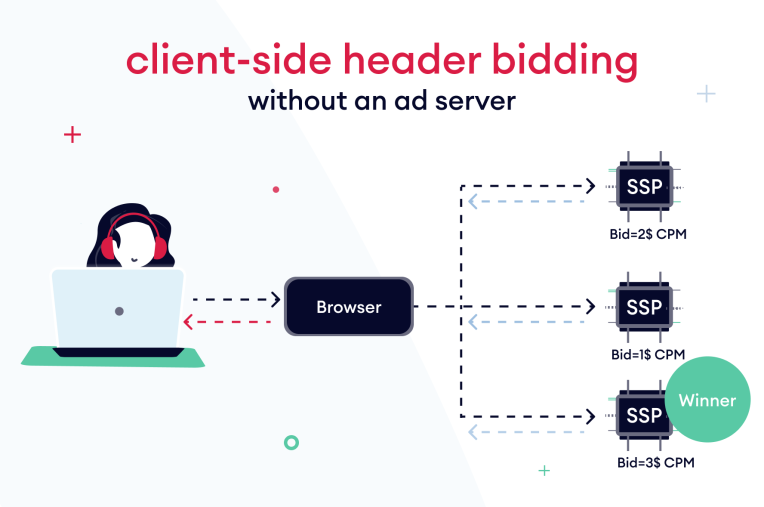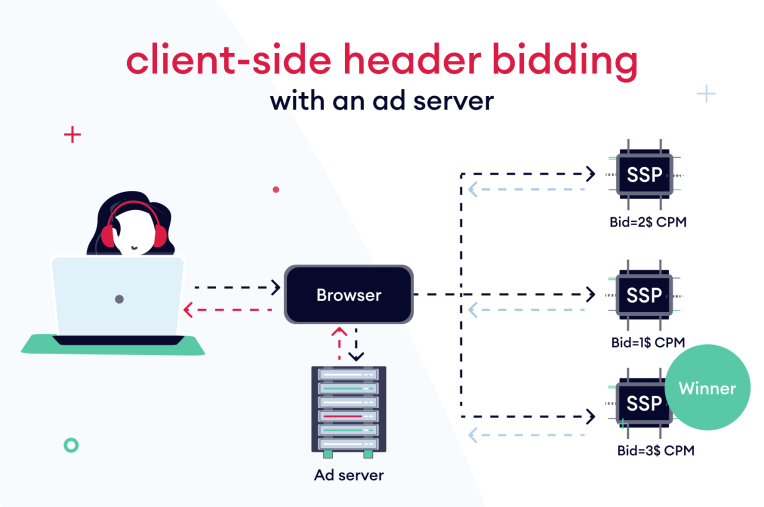
For many publishers, especially those more involved in digital advertising and programmatic, header bidding is a familiar concept. Yet, levels of understanding vary widely. Given the scope of this topic, a deeper dive and grasp of header bidding types can be valuable. Let’s start!

Header bidding definition
Header bidding is an advanced technique that uses the programmatic system, enabling the selling of ad inventory. Thanks to it, an auction takes place, during which many different advertisers compete simultaneously to win a spot for their ad. Header bidding got its name from a JavaScript code – “wrapper” – placed in the website’s code’s header. This wrapper lets bidders know that the auction is taking place. There are two main types of header bidding (they can also be used at the same time):
- Server-side – the ad auction occurs on an external server;
- Client-side – the ad auction is run inside the user’s browser;
- Hybrid setup – mix the two abovementioned approaches so that the highest-paying option can be selected.
Server side header bidding
In server-side header bidding, the most crucial part – selecting the winning ad is executed by a server. The step-by-step process looks like this:
- As soon as the user visits the page, it begins loading, and the ad request is automatically sent to the prebid server;
- The server contacts multiple SSPs. In return, they answer simultaneously with bids;
- The prebid server picks the top bid, and it’s passed to the publisher’s web browser and next to the publisher’s ad server;
- The user gets the chance to see the winner ad!

Client side header bidding
Client-side header bidding, also called browser-side header bidding, is the most common method used by publishers and ad companies today. The auction for ad space runs right in the user’s web browser, for instance, in Chrome or Firefox. Client-side header bidding has two possible setups:
- one that doesn’t include an ad server,
- and one that includes an ad server.
Here’s how the first subtype of client-side header bidding works:
- After the user visits the page, the loading begins. Simultaneously, JavaScript code embedded in the site’s source runs, sending ad requests from the user’s browser to multiple SSPs;
- Next, all the bids are returned to the browser, where the highest bid wins;
- The selected ad is shown to the user!

Here’s how the second subtype of client-side header bidding (one that includes an ad server) works:
- As the user accesses the page, it begins loading, and simultaneously, JavaScript code in the site’s source starts to run; ad requests are sent from the browser to several SSPs;
- All bids are then returned to the browser, but in contrast to the previous subtype, this time, another ad request, thanks to the JavaScript code, is triggered – it includes the highest bid;
- It’s sent to the publisher’s ad server (like Google Ad Manager) and partakes in the direct deal process;
- After the highest bid is selected by the server, the website receives the ad code;
- The winner ad is rendered on the page!

Benefits of client side header bidding
Since client-side header bidding remains a market standard and is utilized by many companies, including optAd360, let’s take a closer look at its strengths when compared to the server-side option:
- As the name implies, server-side header bidding happens on the server, which means much of the user’s data, especially cookies, doesn’t reach the ad server. Client-side header bidding allows for more direct access to cookies, resulting in better ad targeting;
- Client-side header bidding offers more transparency than real-time auctions that take place on the external server. It means client-side header bidding provides clarity on participating buyers and winning bids;
- Client-side header bidding is generally easier to set up than server-to-server header bidding. In consequence, the second option may pose challenges for smaller publishers that don’t cooperate with specialists in the field.
Create content – we will do the rest!
After filling out the registration form and successfully passing the verification process (ensuring that the content meets necessary requirements), our partners are provided with full technological support and a dedicated Publisher Services Manager, ready to answer any monetization question you might have and solve any potential issue. Moreover, we speak 17 languages to ensure you feel comfortable and understood during each step of the monetization process. Let’s get started so you don’t need to worry about a thing – you can just watch your ad revenue grow!


